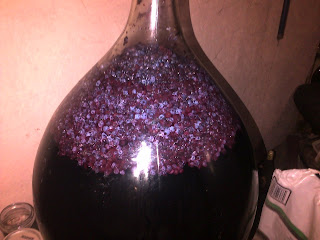16L blueberries
4kg sugar
Lalvin Sparkling wine yeast
Day 1- Put blueberries into carboy without washing to preserve the natural yeast. Boiled sugar in water. Added to carboy. Topped up with water (68L total).
Day 8- Added yeast starter.
Nov 29- Removed airlock. Stirred wine vigorously. Topped up with water. Refit airlock.
Nov 30- Blueberries floated back up over water level, causing wine to bubble up through airlock.
Jan 4- Stirred, topped up, refit airlock. Still have solid blueberries floating on top.
Apr 5- Stirred, topped up, refit airlock. Still have solid blueberries floating on top.
June 2014- Stirred vigorously. Yeast has come out of dormancy. Still have solid blueberries, but air lock is bubbling vigorously again.
Aug 2014 - Stirred vigorously. Thin layer of solid blueberries, air lock still bubbling.
Jan 2, 2015 - Racked into 2 22L carboys. Taste tested. Mild blueberry flavour. Sour. No alcohol reading. Topped with Sugar water- 2kg. Set air locks.
July 7, 2015 - Racked one 22L carboy. Taste tested. Tastes like wine, no blueberry flavour. Set air lock.
 |
| Blueberry and Strawberry Wine |
Summertime Blueberry Wine
Makes 5 gallons (19 L)
15 lbs. (6.8 kg) blueberries
9 lbs. (4 kg) sugar
2–3 cups grape concentrate
(optional — this will add to the
wine’s fruitiness)
2.5 tsp. acid blend
2.5 tsp. pectic enzyme
3 tsp. yeast nutrient
0.18 oz. (5 g) potassium metabisulfite
(approximately 150 ppm SO2)
2 tsp. potassium sorbate
1 tsp. tannin
Yeast (Lalvin EC1118 or
Lalvin 71B-1122)
1. Crush the blueberries.
2. Add the water-sugar mixture and enough water to make 5 gallons (19 L). Add potassium metabisulfite. Cover and let sit for two days.
3. Add sugar, if necessary, to reach specific gravity of 1.090.
4. Add the tannin, acid blend, pectic enzyme and yeast nutrient. Stir everything to blend.
5. Maintain a constant fermentation temperature range between 70–75 °F (21–24 °C).
6. Add yeast to the must.
7. Stir the floating cap of fruit pulp into the fermenting must twice a day during fermentation.
8. Fermentation will continue for approximately 14 to 21 days. Take notice if the bubbles in the airlock have gotten very slow — that is a good sign that the fermentation is coming to an end. Use your hydrometer to monitor and make sure that the fermentation has stopped.
9. Use a mesh bag to extract the juice from the blueberries in the must. Rack the remaining juice to a carboy, leaving the sediment (lees) behind. If possible, move the wine to a cooler place, like a basement, to clear. Rack the wine at least two more times before even thinking about bottling it. Add another Campden tablet to the wine after each racking. The wine should age at least three months.

No comments:
Post a Comment